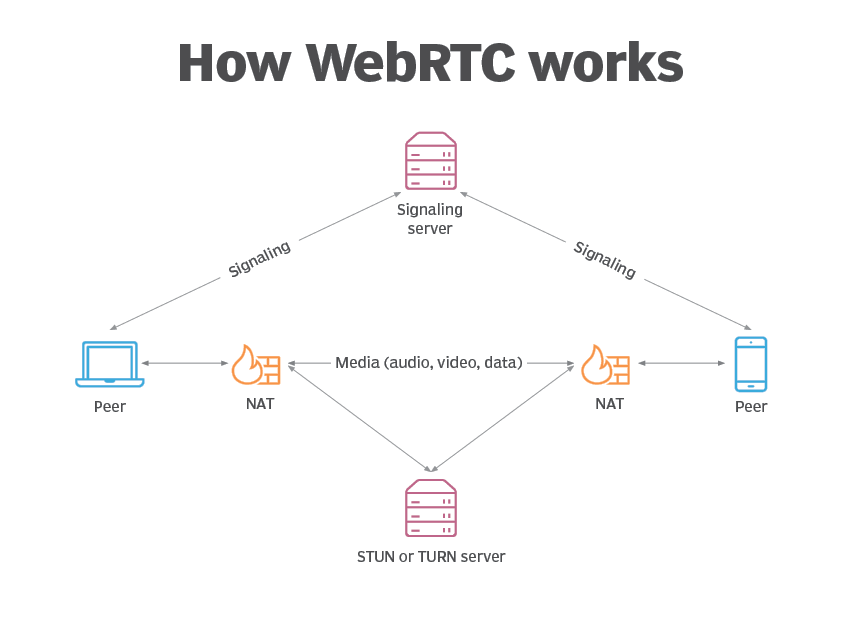Ever joined a video call without downloading an app? Or used a web-based voice chat that just worked without asking for plugins? That’s WebRTC in action! WebRTC (Web Real-Time Communication) is a game-changer for seamless online communication. It enables browsers to exchange audio, video, and data in real-time—without needing third-party software.
As someone who works with proxies and online communication tools, I’ve seen firsthand how WebRTC makes things easier but also brings some security challenges. If you’ve ever worried about your real IP address leaking while using a VPN or proxy, WebRTC is something you should understand. In this guide, I’ll break down what WebRTC is, how it works, and how to use it securely.

1. What It Is and How It Works
What is WebRTC?
WebRTC (Web Real-Time Communication) is an open-source project that enables peer-to-peer communication directly in web browsers. It’s built into Chrome, Firefox, Edge, and Safari, making it widely accessible for developers and end users alike.
Think of WebRTC as a built-in toolkit that lets websites handle live communication—whether it’s video conferencing, voice calling, or real-time data exchange. No need for plugins like Flash (which we’re all glad to see disappear) or extra software.
How it Works
WebRTC operates using three core technologies:
- RTCPeerConnection – Handles audio and video streaming between users.
- RTCDataChannel – Manages real-time data transfers, such as chat messages or file sharing.
- MediaStream API – Controls access to your webcam and microphone.
A peer-to-peer (P2P) connection is established, meaning the data goes directly between two users without a middleman. This makes WebRTC super-fast and efficient—but as we’ll discuss later, it can also expose your real IP address.

2. Key Features and Benefits
It is widely used for a reason—actually, multiple reasons! Here are some of the biggest advantages:
- Real-time communication – Video calls, voice chats, and data sharing happen instantly, with minimal latency.
- No downloads required – Everything happens right in the browser, making WebRTC very user-friendly.
- Cross-platform compatibility – Works on most browsers and even on mobile devices.
- High-quality streaming – Supports HD video and high-fidelity audio without needing expensive server infrastructure.
- Open-source and free – Any developer can integrate WebRTC into their apps without licensing costs.
As an everyday internet user, you’ve probably benefited from WebRTC without realizing it—whether using Google Meet, Facebook Messenger calls, or even multiplayer browser games.
3. WebRTC and Privacy: The DNS & IP Leak Issue
Now, here’s where things get a little tricky—especially for proxy and VPN users.
How It can Expose Your IP Address
Even if you’re using a VPN or proxy, WebRTC can bypass them and reveal your real IP address. Why? Because WebRTC uses STUN (Session Traversal Utilities for NAT) servers to help establish peer-to-peer connections. These servers request your public and private IP addresses to create the connection, potentially exposing them to websites and third parties.
I remember the first time I tested WebRTC leaks while using a proxy. I thought I was fully anonymous, but a simple online WebRTC leak test showed my real IP address! This is why understanding WebRTC is critical if you care about privacy.
How to Prevent Leaks
- Disable WebRTC in your browser (Best for privacy but might break some sites)
- Chrome: Use an extension like WebRTC Leak Prevent.
- Firefox: Go to
about:config, search formedia.peerconnection.enabled, and set it to false. - Edge/Safari: No built-in way, but proxies/VPNs can help.
- Use a VPN or Proxy with WebRTC Protection
- Some VPNs, like NordVPN and ExpressVPN, automatically block WebRTC leaks.
- Proxies that route WebRTC traffic correctly (like residential proxies) help prevent exposure.
- Test for Leaks
- Websites like ipleak.net or browserleaks.com show if your real IP is exposed.
4. Use Cases: Where and How It’s Used
WebRTC is everywhere! Here are some of the most common uses:
- Video Conferencing – Google Meet, Zoom, Microsoft Teams.
- VoIP & Messaging – WhatsApp, Discord, Facebook Messenger.
- Live Streaming & Broadcasting – Web-based video chat apps.
- File Sharing & P2P Communication – Direct file transfers without servers.
- Online Gaming & Interactive Apps – Real-time multiplayer experiences.
5. WebRTC vs. Traditional Communication Technologies
WebRTC has advantages over older technologies, but it’s not perfect.
| Feature | WebRTC | VoIP (SIP/Zoom) | VPN/Proxy Security |
|---|---|---|---|
| P2P Communication | ✅ Yes | ❌ No (server-based) | ❌ No |
| Low Latency | ✅ Yes | ✅ Yes | ❌ No |
| IP Leak Risk | ⚠️ Yes | ❌ No | ✅ No if configured properly |
| Ease of Use | ✅ Yes | ❌ No (install needed) | ❌ No (manual setup) |
While WebRTC is great for communication, it needs proper configuration for privacy-conscious users.
6. Setting Up WebRTC for Secure & Private Communication
If you’re using WebRTC for private or business communication, consider these best practices:
- Use a VPN or Proxy that Blocks WebRTC Leaks – Not all VPNs handle WebRTC well. Look for one with built-in WebRTC protection.
- Implement WebRTC Security in Your App – If you’re developing a WebRTC app, use end-to-end encryption (E2EE) and secure STUN/TURN servers.
- Regularly Check for WebRTC Leaks – Visit browserleaks.com periodically to see if your VPN/proxy is working properly.
Conclusion
WebRTC is a powerful tool that makes real-time communication seamless, but it comes with privacy risks—especially for proxy and VPN users. By understanding how WebRTC works and taking steps to prevent leaks, you can enjoy its benefits without sacrificing your online anonymity.
If you use WebRTC-powered apps like Google Meet or Discord, test your setup to ensure your real IP isn’t exposed. Staying informed is key to balancing performance and security in today’s digital world. 🚀